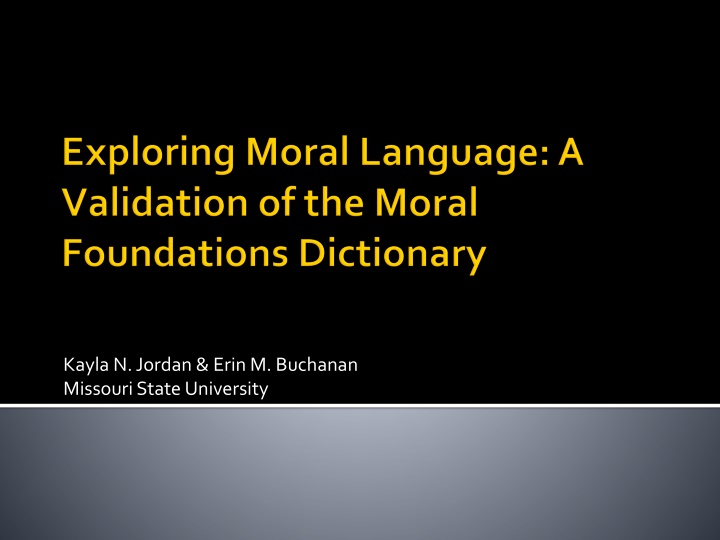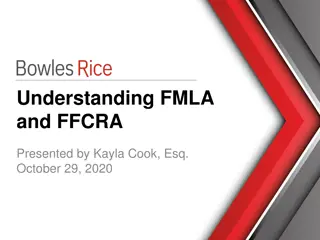
Moral Foundations: Liberal vs Conservative Perspectives
Explore the differences in moral foundations between liberals and conservatives, focusing on Harm/Care, Fairness/Reciprocity, Ingroup/Loyalty, Authority/Respect, and Purity/Sanctity. Discover how language and moral values play a role in political debates like the abortion discussion in Congress.
Download Presentation

Please find below an Image/Link to download the presentation.
The content on the website is provided AS IS for your information and personal use only. It may not be sold, licensed, or shared on other websites without obtaining consent from the author. If you encounter any issues during the download, it is possible that the publisher has removed the file from their server.
You are allowed to download the files provided on this website for personal or commercial use, subject to the condition that they are used lawfully. All files are the property of their respective owners.
The content on the website is provided AS IS for your information and personal use only. It may not be sold, licensed, or shared on other websites without obtaining consent from the author.
E N D
Presentation Transcript
Kayla N. Jordan & Erin M. Buchanan Missouri State University
Intuitions over rationality Five moral foundations Harm/Care Fairness/Reciprocity Ingroup/Loyalty Authority/Respect Purity/Sanctity (Graham, Haidt, & Nosek, 2009; Graham, Nosek, & Haidt, 2012; Graham et al., 2011) 2
Liberals Rely on Harm/Care and Fairness/Reciprocity Conservatives Rely on all five moral foundations 3
30-items; two subscales (Graham et al., 2011) Moral Relevance 1 (not at all relevant) to 6 (extremely relevant) Whether or not someone used violence (Harm) , Whether or not someone was denied his or her rights (Fairness) , Whether or not someone showed a lack of loyalty (Ingroup) , Whether or not an action caused chaos or disorder (Authority) , Whether or not someone did something disgusting (Purity) . Moral Judgments 1 (strongly disagree) to 6 (strongly agree) One of the worst things a person can do is hurt a defenseless animal (Harm) , Justice is the most important requirement of a society (Fairness) , I am proud of my country s history (Ingroup) , Men and women each have different roles to play in society (Authority) , Chastity is an important and valuable virtue (Purity) 4
Harm Example words: safe, peace, protect, defend, war, kill, abuse, destroy, exploit Fairness Example words: equal, justice, rights, tolerant, bias, favoritism, exclusion Ingroup Example words: nation, family, patriot, unite, ally, foreign, enemy, treason, terrorism, immigrant Authority Example words: obey, law, tradition, hierarchy, control, rebel, dissent, insurgent, oppose, protest, riot Purity Example words: piety, clean, sacred*, holy, integrity, virtuous, innocent, sin, whore, taint, stain, tarnish, debase*, desecrate, wicked*, blemish, exploitative, pervert, wretched 5
Liberal ministers used more harm, fairness, and ingroup words Conservative ministers used more authority and purity words (Graham, Haidt, & Nosek, 2009) Abortion debate in Congress: Republicans used more moral language overall Republicans used more purity words Democrats used more fairness words. (Sagi & Dehghani, 2013) 6
The purpose of the current study is to validate the MFD as a measure of moral language. Hypothesis 1 (construct validity): Using multi-method, multi-trait (MTMM) analyses, the MFD should measure endorsement of moral foundations similarly to the MFQ. Hypothesis 2 (predictive validity): The MFD should predict political orientation in the same ways as the MFQ. 7
290 undergraduate students 161 men; 129 women 80% Caucasian Political orientation M = 4.67, SD = 2.22 Scale: 1 (conservative) to 10 (liberal) 158 participants deleted 8
Primed with fictitious news stories about use of chemical weapons by Syrian government Writing prompt Please write for five to ten minutes about your reaction to Syria's use of chemical weapons and United States' reaction. MFQ Demographics Please rate your political orientation on a scale from 1 (conservative) to 10 (liberal) 9
162 undergraduate students 48 men; 114 women 89% Caucasian Political orientation M = 5.02, SD = 2.34 33 participants deleted 10
Randomly assigned to one of three writing prompts Abortion Same-sex marriage Environmentalism MFQ Demographics Please rate your political orientation on a scale from 1 (conservative) to 10 (liberal) 11
Model Comparisons 2 Model df CFI RMSEA Model 1 Correlated traits and methods 903.577 512 .875 .054 Model 2 No traits, correlated methods 2044.664 557 .524 .101 Model 3 Perfectly correlated traits, correlated methods Model 4 Correlated traits, uncorrelated methods 1214.668 522 .778 .071 905.811 513 .874 .054 13
Factor loadings of MFD Factor Loadings Bayesian Estimates Estimate S.E. P Mean S.E. HD<--Harm -0.02 0.01 0.001 -0.02 0.000 FD<--Fairness -0.01 0.00 0.046 -0.01 0.000 IGD<--Ingroup 0.03 0.01 *** 0.03 0.000 AD<--Authority 0.00 0.01 0.511 0.00 0.000 PD<--Purity 0.00 0.00 0.231 0.00 0.000 HD<--MFD 0.07 0.01 *** 0.07 0.001 FD<--MFD 0.02 0.00 *** 0.02 0.000 IGD<--MFD 0.05 0.01 *** 0.05 0.001 AD<--MFD 0.00 0.01 0.417 0.00 0.000 PD<--MFD 0.02 0.00 *** 0.02 0.000 14
Regression coefficients for MFQ and MFD predicting political orientation pr2 B SE 95% CI B t p Lower Upper 0.03 MFQ Harm 0.52 0.20 0.13 0.90 0.18 2.64 0.009 0.06 Fairness 0.88 0.21 0.46 1.30 0.28 4.13 <.001 Ingroup -0.30 0.20 -0.69 0.09 -0.12 -1.52 0.129 0.01 Authority -0.44 0.22 -0.87 0.00 -0.15 -1.97 0.05 0.02 0.08 Purity -0.70 0.14 -0.98 -0.42 -0.33 -4.86 <.001 MFD Harm 2.05 1.34 -0.59 4.70 0.10 1.53 0.128 0.01 Fairness -1.60 3.28 -8.05 4.86 -0.03 -0.49 0.627 <.01 Ingroup -1.70 1.36 -4.38 0.99 -0.08 -1.25 0.214 0.01 Authority -1.68 2.26 -6.13 2.77 -0.05 -0.74 0.458 <.01 Purity -5.21 3.14 -11.39 0.97 -0.11 -1.66 0.098 0.01
The Moral Foundations Dictionary does not seem to be a valid measure of moral foundations. Problems with the MFD: Low base rates of words Out of 82,000 words, 1350 (2%) were MFD words. Context Reliability of MFQ 16
Federico, C. M., Weber, C. R., Ergun, D., & Hunt, C. (2013). Mapping the Connections between Politics and Morality: The Multiple Sociopolitical Orientations Involved in Moral Intuition. Political Psychology, 34(4), 589-610. doi: 10.1111/pops.12006 Graham, J., Haidt, J., & Nosek, B. A. (2009). Liberals and conservatives rely on different sets of moral foundations. J Pers Soc Psychol, 96(5), 1029-1046. doi: 10.1037/a0015141 Graham, J., Nosek, B. A., Haidt, J., Iyer, R., Koleva, S., & Ditto, P. H. (2011). Mapping the moral domain. J Pers Soc Psychol, 101(2), 366-385. doi: 10.1037/a0021847 Graham, J., Nosek, B. A., & Haidt, J. (2012). The moral stereotypes of liberals and conservatives: exaggeration of differences across the political spectrum. PLoS One, 7(12), e50092. doi: 10.1371/journal.pone.0050092 Sagi, E., & Dehghani, M. (2013). Measuring moral rhetoric in text. Social Science Computer Review, 32(2), 132-144. Weber, C. R., & Federico, C. M. (2013). Moral Foundations and Heterogeneity in Ideological Preferences. Political Psychology, 34(1), 107-126. doi: 10.1111/j.1467-9221.2012.00922.x Contact: Kayla Jordan (kaylajordan91@gmail.com) 17










